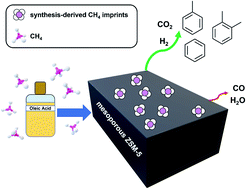Methane assisted catalyst synthesis and catalytic conversion of oleic acid†
Abstract
Fatty acid deoxygenation is an important process if we are to realize the use of biocrudes as replacements for fossil fuels. A ZSM-5 support with 40% higher pore volume and increased surface area is realized by assisted synthesis under CH4. The catalyst exhibits a very good performance for deoxygenation of oleic acid (92% by mole) and selectivities towards aromatics (50.8 wt%) and syngas (14.8 wt%) when loaded with 5% Ce, 0.5% Ga, and 0.5% Pt metal particles. CH4 is also employed as the coreactant at mild temperature and pressure (400 °C and 30 bar) in a batch system. CH4 conversion is greatly enhanced over the CH4-synthesized support and is shown by 13CH4 experiments and 13C NMR to directly incorporate into the benzylic sites of the aromatics in the liquid product as well as CO2 in the gas phase. XPS is used to show that metal species (particularly Ce) are partially reduced prior to reaction, resulting from the ejection of CH4 pools trapped in the framework during synthesis, removing the need for a potentially expensive and time-consuming pre-reduction step. DSC and TPD studies also show that this material has a significantly higher capacity for methane adsorption, a potential result of methane imprinting from the synthesis process.



 Please wait while we load your content...
Please wait while we load your content...